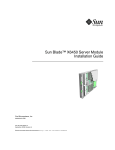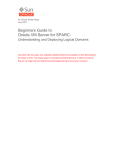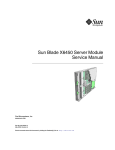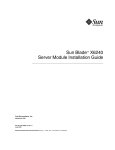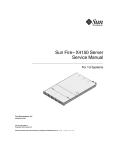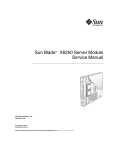Download Sun Blade X6250 Server Module Installation Guide
Transcript
Sun Blade™ X6250 Server Module Installation Guide Sun Microsystems, Inc. www.sun.com Part No. 820-1182-16 May 2009, Revision A Submit comments about this document at: http://www.sun.com/hwdocs/feedback Copyright © 2009 Sun Microsystems, Inc., 4150 Network Circle, Santa Clara, California 95054, U.S.A. All rights reserved. This distribution may include materials developed by third parties. Sun, Sun Microsystems, the Sun logo, Java, Netra, Solaris, Sun Ray, Sun™ ONE Studio, Sun Blade X6250 Server Module, Sun StorageTek™ RAID Manager software and Sun company logo are trademarks or registered trademarks of Sun Microsystems, Inc., or its subsidiaries, in the U.S. and other countries. Intel® is a trademark or registered trademark of Intel Corporation or its subsidiaries in the United States and other countries. Intel® Xeon® is a trademark or registered trademark of Intel Corporation or its subsidiaries in the United States and other countries. Intel Inside® is a trademark or registered trademark of Intel Corporation or its subsidiaries in the United States and other countries. Use of any spare or replacement CPUs is limited to repair or one-for-one replacement of CPUs in products exported in compliance with U.S. export laws. Use of CPUs as product upgrades unless authorized by the U.S. Government is strictly prohibited. DOCUMENTATION IS PROVIDED "AS IS" AND ALL EXPRESS OR IMPLIED CONDITIONS, REPRESENTATIONS AND WARRANTIES, INCLUDING ANY IMPLIED WARRANTY OF MERCHANTABILITY, FITNESS FOR A PARTICULAR PURPOSE OR NON-INFRINGEMENT, ARE DISCLAIMED, EXCEPT TO THE EXTENT THAT SUCH DISCLAIMERS ARE HELD TO BE LEGALLY INVALID. Copyright © 2009 Sun Microsystems, Inc., 4150 Network Circle, Santa Clara, California 95054, Etats-Unis. Tous droits réservés. Cette distribution peut comprendre des composants développés par des tierces parties. Sun, Sun Microsystems, le logo Sun, Java, Netra, Solaris, Sun Ray, Sun™ ONE Studio, Sun Blade X6250 Server Module, Sun StorageTek™ RAID Manager software et Sun company logo sont des marques de fabrique ou des marques déposées de Sun Microsystems, Inc., ou ses filales, aux Etats-Unis et dans d'autres pays. Intel® est une marque de fabrique ou une marque déposée de Intel Corporation ou de sa filiale aux Etats-Unis et dans d'autres pays. Intel® Xeon® est une marque de fabrique ou une marque déposée de Intel Corporation ou de sa filiale aux Etats-Unis et dans d'autres pays. Intel Inside® est une marque de fabrique ou une marque déposée de Intel Corporation ou de sa filiale aux Etats-Unis et dans d'autres pays. L'utilisation de pieces detachees ou d'unites centrales de remplacement est limitee aux reparations ou a l'echange standard d'unites centrales pour les produits exportes, conformement a la legislation americaine en matiere d'exportation. Sauf autorisation par les autorites des EtatsUnis, l'utilisation d'unites centrales pour proceder a des mises a jour de produits est rigoureusement interdite. LA DOCUMENTATION EST FOURNIE "EN L'ETAT" ET TOUTES AUTRES CONDITIONS, DECLARATIONS ET GARANTIES EXPRESSES OU TACITES SONT FORMELLEMENT EXCLUES, DANS LA MESURE AUTORISEE PAR LA LOI APPLICABLE, Y COMPRIS NOTAMMENT TOUTE GARANTIE IMPLICITE RELATIVE A LA QUALITE MARCHANDE, A L'APTITUDE A UNE UTILISATION PARTICULIERE OU A L'ABSENCE DE CONTREFACON. Please Recycle Contents Preface 1. vii Introduction 1 Terms and References Used in This Book Installation Overview 1 2 Routine Power On and Power Off To Apply Standby Power 3 3 ▼ To Power on Main Power for All Server Components ▼ To Shut Down Main Power 3 5 ▼ To Control the Locate LED Using the ILOM Web Interface ▼ To Control the Locate LED Using the ILOM Command Line Interface (CLI) 6 Operating System Installation Options Compact Flash Drive 5 6 7 Solid State Disk Drive (SSD) Connecting to SAS Devices 7 7 Internal Connection to a Sun Blade 6000 Disk Module 9 External Connecton to the 10 GbE Ethernet Connections 9 Connecting to Exterior Storage Devices Using a Fibre Channel Connection 10 RAID Configuration 10 iii ▼ To Configure the Sun Blade RAID 5 Expansion Module Dongle Cable Connections 2. 11 Installing and Configuring the Server Module Inserting the Server Module ▼ 13 13 To Insert the Server Module LED Behavior 13 15 Accessing and Configuring the ILOM Service Processor Service Processor Overview 17 Upgrading or Migrating the Service Processor 17 Displaying the Service Processor’s IP Address 17 To Display the Service Processor’s IP Address Connecting to the ILOM 16 16 Service Processor Versions ▼ 11 18 18 ▼ To Connect to the ILOM Web Interface ▼ To Connect to the ILOM CLI 19 20 Configuring the Service Processor’s Network Settings (Optional) ▼ 21 To Configure the Service Processor’s Network Configuration: Accessing the System Console 21 22 ▼ To Access the System Console Directly ▼ To Access the System Console Using the ILOM CLI ▼ To Access the System Console Using the ILOM Web Interface Configuring or Installing an Operating System 22 23 23 25 Powering On the System and Configuring the Preinstalled Solaris Operating System 26 ▼ To Power On the Server Module and Configure the Preinstalled Solaris Operating System 26 Power Management 28 Initial Setup of the Factory-Installed Microsoft Windows Server 2003 R2 SP2 Operating System 29 iv Sun Blade X6250 Server Module Installation Guide • May 2009 Hardware and Software Prerequisites 29 Establishing Connection to the Server Module 30 Providing Customer Information for Windows Setup Obtaining Updates Using SunLink A. Installation Worksheet Index 30 31 33 37 Contents v vi Sun Blade X6250 Server Module Installation Guide • May 2009 Preface This Sun Blade X6250 Server Module Installation Guide provides procedures for installing the server in a chassis, connecting to the service processor, and configuring the preinstalled Solaris™ Operating System and the preinstalled Windows Server 2003 operating system. Using UNIX Commands This document might not contain information about basic UNIX® commands and procedures such as shutting down the system, booting the system, and configuring devices. Refer to the following for this information: ■ Software documentation that you received with your system ■ Solaris Operating System documentation, which is at: http://docs.sun.com vii Shell Prompts Shell Prompt C shell machine-name% C shell superuser machine-name# Bourne shell and Korn shell $ Bourne shell and Korn shell superuser # Typographic Conventions Typeface* Meaning Examples AaBbCc123 The names of commands, files, and directories; on-screen computer output Edit your.login file. Use ls -a to list all files. % You have mail. AaBbCc123 What you type, when contrasted with onscreen computer output % su Password: AaBbCc123 Book titles, new words or terms, words to be emphasized. Replace command-line variables with real names or values. Read Chapter 6 in the User’s Guide. These are called class options. You must be superuser to do this. To delete a file, type rm filename. * The settings on your browser might differ from these settings. Related Documentation For a description of the document set, see the Where to Find Documentation sheet that is packed with your system and also posted at the product’s documentation site. Go to the following URL, then navigate to your product. http://docs.sun.com viii Sun Blade X6250 Server Module Installation Guide • May 2009 Translated versions of some of these documents are available at the web site described above in French, Simplified Chinese, Traditional Chinese, Korean, and Japanese. English documentation is revised more frequently and might be more upto-date than the translated documentation. For all Sun hardware documentation, go to the following URL: http://docs.sun.com Documentation, Support, and Training Sun Function URL Documentation http://docs.sun.com/ Support http://www.sun.com/support/ Training http://www.sun.com/training/ Product Updates For product updates that you can download, please visit the following web site: http://www.sun.com/download/ Find the Hardware Drivers section and click X64 Servers & Workstations. The Sun Blade X6250 Server Module site contains updates for firmware and drivers, as well as CD-ROM ISO images. Third-Party Web Sites Sun is not responsible for the availability of third-party web sites mentioned in this document. Sun does not endorse and is not responsible or liable for any content, advertising, products, or other materials that are available on or through such sites or Preface ix resources. Sun will not be responsible or liable for any actual or alleged damage or loss caused by or in connection with the use of or reliance on any such content, goods, or services that are available on or through such sites or resources. Sun Welcomes Your Comments Sun is interested in improving its documentation and welcomes your comments and suggestions. You can submit your comments by going to: http://www.sun.com/hwdocs/feedback Please include the title and part number of your document with your feedback: Sun Blade X6250 Server Module Installation Guide, part number 820-1182-16. x Sun Blade X6250 Server Module Installation Guide • May 2009 CHAPTER 1 Introduction This chapter contains the following topics: ■ “Terms and References Used in This Book” on page 1 ■ “Installation Overview” on page 2 ■ “Routine Power On and Power Off” on page 3 ■ “To Apply Standby Power” on page 3 ■ “Operating System Installation Options” on page 6 ■ “RAID Configuration” on page 10 ■ “Dongle Cable Connections” on page 11 Terms and References Used in This Book Note the following terms used in this book: ■ The term server module refers to the Sun Blade X6250 server hardware. ■ The term chassis refers to the Sun Blade 6000 modular system. ■ The term remote drive refers to a disk drive that is located outside the server module, but is configured to serve as a local drive. ■ The server module includes a service processor (SP), which is an embedded system separate from the host system. It supports remote management through multiple protocols including IPMI, and is available whenever external power is supplied to the server module through the chassis. The SP can be equipped with one of several versions of the SP software: ■ Integrated Lights Out Manager (ILOM) 3.0 – Sun Blade X6450 server modules are currently shipped with ILOM 3.0. ■ Integrated Lights Out Manager (ILOM) 2.0 – Some Sun Blade X6420 server modules might be equipped with ILOM 2.0 software. 1 ■ Embedded Lights Out Manager (ELOM) – Earlier Sun Blade X6450 server modules might be equipped with this version of the service processor software. Installation Overview The following paragraphs provide an outline of the a routine installation using the preinstalled Solaris operating system. The actual procedures are in Chapter 2. Unpack the server module before proceeding. 1. Insert the server module into the chassis. ■ When you are done, the server module comes up to standby mode. ■ See “Inserting the Server Module” on page 13. 2. Access and configure the service processor. Using the service processor, you can: ■ Access the system console remotely over the network. ■ Access the service processor’s IP address and MAC address. ■ Change the service processor’s IP address, and configure whether the service processor uses DHCP or static addressing. See “Configuring the Service Processor’s Network Settings (Optional)” on page 21. When you are done, you can access the service processor from the Ethernet. You can also set the service processor’s network settings, including its IP address and hostname at this time. 3. Access the system console. See “Accessing the System Console” on page 22. 4. Install or configure your operating system. ■ If your server module is equipped with the preinstalled Solaris operating system, follow the instructions in “Powering On the System and Configuring the Preinstalled Solaris Operating System” on page 26. ■ If your server is equipped with the preinstalled Windows Server 2003 operating system, follow the instructions in “Initial Setup of the FactoryInstalled Microsoft Windows Server 2003 R2 SP2 Operating System” on page 29. 5. To install a different operating system: 2 ■ To install a supported Solaris, Linux, or VMware operating system, see the Sun Blade X6250 Server Module Operating System Installation Guide. ■ To install a supported Windows operating system, see the Sun Blade X6250 Server Module Windows Operating System Installation Guide. Sun Blade X6250 Server Module Installation Guide • May 2009 Routine Power On and Power Off This section describes how to apply standby power to the server module so you can operate the service processor. It also includes procedures for powering on and for shutting down the server module. Note – You can also power on and power off the server module remotely using the service processor. Powering on is described in “Powering On the System and Configuring the Preinstalled Solaris Operating System” on page 26. More complete instructions are provided in the corresponding service processor documentation. To Apply Standby Power When standby power is applied, the service processor is powered on, and everything else is powered off. If the chassis is powered on, standby power is automatically applied to the server module. No action is required. ▼ To Power on Main Power for All Server Components 1. Insert the server module into a powered chassis. The server module comes up to standby power mode automatically. In standby power mode, the green OK LED on the front panel flashes. The blue OK to Remove LED remains ON with ILOM 2.0 and ELOM. It remains Off with ILOM 3.0. See FIGURE 1-1. 2. Use a non-conducting pointed object, such as a wooden or plastic stylus, to press and release the recessed Power button on the server front panel. When main power is applied to the server, the green OK LED above the Power button lights and remains lit. Chapter 1 Introduction 3 FIGURE 1-1 Server Module Front Panel . Figure Legend 4 1 White LED - Locate. Use it to identify the server module. When turned on, the locate LED blinks at .25Hz for 30 minutes. To turn it on or off, press it momentarily, or use the ILOM as described in: - “To Control the Locate LED Using the ILOM Web Interface” on page 5 or - “To Control the Locate LED Using the ILOM Command Line Interface (CLI)” on page 6. 2 Blue LED - Ready to remove. Use ILOM 3.0 commands to turn it On and Off 3 Amber LED - Service action required 4 Green LED - OK. See “LED Behavior” on page 15 for details. 5 Power On/Standby button 6 For service use only 7 UCP (universal connector port), used for dongle cable 8 Green LED - Disk OK 9 Amber LED - Disk service action required 10 Blue LED - Disk ready to remove Sun Blade X6250 Server Module Installation Guide • May 2009 ▼ To Shut Down Main Power To power off the server, use one of the following two methods: ■ Graceful shutdown. Use a non-conducting pointed object, such as a stylus, to press and release the Power button on the front panel. This causes Advanced Configuration and Power Interface (ACPI) enabled operating systems to perform an orderly shutdown of the operating system. Servers not running ACPI-enabled operating systems will shut down to standby power mode immediately. ■ Emergency shutdown. Press and hold the Power button for four seconds to force main power off and enter standby power mode. When main power is off, the Power/OK LED on the front panel will begin flashing, indicating that the server is in standby power mode. ■ To power off the server completely. Remove the server from the chassis, or disconnect the AC power cords from the back panel of the chassis. Note – Pressing the Power button for four seconds or more always causes the subsystems in the server module (except for the service processor) to be powered off, even if the server module is already in the powered-off state. If the server module is already in the powered-off state when the Power button is depressed for four seconds or more, power is briefly applied to the system, then it is turned off again. ▼ To Control the Locate LED Using the ILOM Web Interface 1. Log in to the ILOM web interface. See “To Connect to the ILOM Web Interface” on page 19 for details. 2. Navigate to System Monitoring -> Indicators. 3. Select the radio button next to /SYS/LOCATE. 4. Select an action from the drop-down menu: ■ Set LED To Fast Blink to turn the LED on. ■ Turn LED Off to turn the LED off. Chapter 1 Introduction 5 ▼ To Control the Locate LED Using the ILOM Command Line Interface (CLI) 1. Log in to the ILOM CLI. See “To Connect to the ILOM CLI” on page 20 for details. 2. Use the following commands: ■ /SYS/LOCATE value=FastBlink to turn the LED on. ■ /SYS/LOCATE value=Off to turn the LED off. Operating System Installation Options The Sun Blade X6250 can be configured to install the operating system in a wide variety of locations other than on the local hard drives. This section describes some of the options available. They include: ■ Installing the operating system on the compact flash, which shares characteristics with a hard drive, and which can support some operating systems. This option is described in “Compact Flash Drive” on page 7. ■ Installing the operating system on the SSD, or Solid State Disk device. See “Solid State Disk Drive (SSD)” on page 7. ■ Configure diskless network boot, which boots the server module from a boot image on another server. See the Sun Blade X6250 Server Module Operating System Installation Guide or your operating system documentation for more information. ■ Installing the operating system on a remote drive, which might be in the chassis (connected through the SAS-NEM module to a Sun Blade 6000 Disk Module) or outside the chassis, in a storage device such as a SAN. See “Connecting to SAS Devices” on page 7 and “Connecting to Exterior Storage Devices Using a Fibre Channel Connection” on page 10. The following sections describe methods of configuring remote drives: ■ “Connecting to SAS Devices” on page 7. ■ “Connecting to Exterior Storage Devices Using a Fibre Channel Connection” on page 10. After you have configured one or more remote drives, you can proceed with the operating system installation. From the point of view of the operating system installation, when remote drives are installed and configured correctly, they operate the same as local drives. They should appear in the list when the operating system installation procedure queries for where to install the operating system. 6 Sun Blade X6250 Server Module Installation Guide • May 2009 Compact Flash Drive The Sun Blade X6250 is equipped with a compact flash device that can support some operating systems. It is the only local option for installing an operating system. The following operating systems support booting from compact flash: ■ Solaris 10 8/07 Operating System U4 (64-bit) or later ■ Red Hat Enterprise Linux 4.6 (32/64-bit) or later ■ Red Hat Enterprise Linux 5.0 (64-bit) or later ■ SUSE Linux Enterprise Server 9 Sp4 (64-bit) ■ SUSE Linux Enterprise Server 10 Sp1 (64-bit) or later ■ VMware ESX 3.0.2+ ■ Windows 2003 32-bit and 64-bit ■ Windows 2008 32-bit and 64-bit The compact flash drive supports a finite number of writes before its performance degrades. You can mitigate the limited number of writes by configuring it to redirect the log files (the /var and /tmp directories) to another location. See your operating system documentation for details. Solid State Disk Drive (SSD) The X6250 server module supports installing SSDs in the HDD bays. Each SSD provides 32Gb of SATA capacity. The following conditions apply: ■ SSDs cannot be combined with any other drive, SATA or SAS. ■ SSDs can only be connected through the onboard SATA connection. Connecting to SAS Devices The SAS-NEM module, mounted in the back of the chassis, allows to the Sun Blade X6250 Server Module to connect to SAS devices inside the chassis and outside of the chassis. Each chassis can support one or two SAS-NEM modules. These configurations require the Sun Blade X6250 Server Module to have either a REM or a FEM. ■ Inside the chassis, the Sun Blade 6000 Disk Module provides eight SAS drives. Chapter 1 Introduction 7 The Sun Blade 6000 Disk Module and the Sun Blade X6250 Server Module work in pairs, with the server module in an even-numbered slot, directly to the left of the disk module. Thus, the pairs can be in slots 0+1, 2+3, 4+5, 6+7, or 8+9. In this configuration, the eight disks on the disk module are available to the server module, and appear in the boot list as local drives. ■ Outside the chassis, the Sun Blade 6000 10GbE Multi-Fabric Network Express Module provides four 10 GbE SAS external ports as well as connections to the Sun Blade 6000 Disk Module. For more information, see the Sun Blade 6000 Disk Module Installation Guide (8201702), and the documentation for the corresponding SAS NEM module. The following device requires software 3.0 or newer. ■ Sun Blade 6000 10GbE Multi-Fabric Network Express Module Note – The Sun Blade 6000 10GbE Multi-Fabric Network Express Module can run on a server module equipped with SW2.0.3, CPLD 250 or newer, and a 375-3501-06 or newer motherboard. However to support hot plugging this component requires SW3.0. The following devices require software 2.0 or newer. ■ Sun Blade RAID 5 Expansion Module ■ Sun Blade 6000 Multi-Fabric Network Express Module The following devices require a F540-7821-01 or newer motherboard, with 2.0 software installed. The motherboard part number appears on the motherboard, and can be read using the service processor. ■ Sun Dual 10GbE Fabric Expansion Module The combinations, and the configurations they support appear in TABLE 1-1. TABLE 1-1 SAS Connection Summary REM SAS-NEM Module Supported Connections Sun Blade RAID 5 Expansion Module NEM None Sun Blade RAID 5 Expansion Module Sun Blade 6000 Multi-Fabric Network Express Module Sun Blade 6000 Disk Module External SAS connectors Sun Blade RAID 5 Expansion Module Sun Blade 6000 10GbE Multi-Fabric Sun Blade 6000 Disk Module Network Express Module External SAS connectors Note - This SAS-NEM also supports the 10GbE Ethernet connectors. See “External Connecton to the 10 GbE Ethernet Connections” on page 9. 8 Sun Blade X6250 Server Module Installation Guide • May 2009 FIGURE 1-2 shows a Sun Blade X6250 server module in slot 0 and a Sun Blade 6000 Disk Module in slot 1, with a pair of Sun Blade 6000 10GbE Multi-Fabric Network Express Modules. FIGURE 1-2 Connections to a SAS NEM Module Internal Connection to a Sun Blade 6000 Disk Module Inside the chassis, the Sun Blade 6000 Disk Module provides eight SAS drives. The Sun Blade 6000 Disk Module and the Sun Blade X6250 Server Module work in pairs, with the server module in an even-numbered slot, directly to the left of the disk module. Thus, the pairs can be in slots 0+1, 2+3, 4+5, 6+7, or 8+9. In this configuration, the eight disks on the disk module are available to the server module, and appear in the boot list as local drives. External Connecton to the 10 GbE Ethernet Connections In addition to the four external SAS connectors, the Sun Blade 6000 10GbE MultiFabric Network Express Module provides ten 10GbE ports. To use the 10GbE ports, you must have a Sun Blade 6000 10GbE Multi-Fabric Network Express Module installed. For more information, see the Sun Blade 6000 Disk Module Installation Guide, and the documentation for the SAS NEM module. Chapter 1 Introduction 9 Connecting to Exterior Storage Devices Using a Fibre Channel Connection The Sun Blade X6250 supports connections to an external SAN over a fibre channel link provided by a PCIe ExpressModule card in the corresponding PCIe ExpressModule slot. The PCIe ExpressModule card provides a fibre channel connection to the external SAN. FIGURE 1-3 shows the configuration. FIGURE 1-3 PCIe ExpressModule with Fibre Channel and SAN The chassis supports two PCIe ExpressModule slots for each server slot. They are numbered N-0 and N-1, where N is the server slot number. The numbering is described in the chassis documentation. See the documentation provided with the PCIe ExpressModule card for more details. RAID Configuration RAID configuration requires an (optional) RAID Expansion Module (REM). Note – This section only applies to server modules equipped with a Sun Blade RAID 5 Expansion Module. 10 Sun Blade X6250 Server Module Installation Guide • May 2009 Caution – If you are going to include your boot drive in a RAID array, you must configure it before installing the operating system. See “To Configure the Sun Blade RAID 5 Expansion Module” on page 11. ▼ To Configure the Sun Blade RAID 5 Expansion Module 1. Power on the server module. 2. Use Ctrl-A to open the configuration utility. 3. Use the utility to create a volume for each disk or each RAID that you want the server’s BIOS (and OS if installed) to see. The BIOS utility can create up to 20 volumes. Each volume can contain a single disk or a RAID (RAID levels 0, 1, 1E, 10, 5, or 6) with global or dedicated hot spares. Each volume created by the BIOS Utility will be seen by the server’s BIOS as a single disk drive. For additional information, see the Sun Intel Adaptec BIOS RAID Utility User's Manual. Dongle Cable Connections A dongle cable allows you to connect hardware directly to the front panel of the server module. It supports a video, serial, and USB connections. It provides one method of accessing the system console, as described in “Accessing the System Console” on page 22. The dongle cable connection appears in FIGURE 1-4. Note – The dongle cable has either three or four connectors. FIGURE 1-4 shows a dongle with four connectors. The three-connector dongle does not have the DB9 serial console connector (1). Caution – Disconnect the dongle cable from the connector on the front panel when you are not using it. Chapter 1 Introduction 11 FIGURE 1-4 Dongle Cable Connections 4 3 2 1 Figure Legend 12 1 DB9 serial console to server module service processor. This connector is not present on a three-connector dongle. 2 VGA video connector. 3 RJ45 connector. - On a three-connector dongle, this connector provides serial access to the service processor. - On a four-connector dongle, this connector is unused. 4 Dual USB connectors. Sun Blade X6250 Server Module Installation Guide • May 2009 CHAPTER 2 Installing and Configuring the Server Module This chapter provides instructions for installing and configuring the server module. It contains the following sections: ■ “Inserting the Server Module” on page 13 ■ “Accessing and Configuring the ILOM Service Processor” on page 16 ■ “Accessing the System Console” on page 22 ■ “Configuring or Installing an Operating System” on page 25 Inserting the Server Module Caution – Before handling components, attach an electrostatic discharge (ESD) wrist strap to bare metal on the chassis. Both the front and back of the chassis have grounded locations. The system’s printed circuit boards and hard disk drives contain components that are extremely sensitive to static electricity. ▼ To Insert the Server Module 1. Locate the desired slot in the chassis. 2. To eject the filler panel, pull the lever out. Do not discard the filler panel. 13 Caution – Do not operate the system with empty slots. Always insert a filler panel into an empty slot to reduce the possibility of module shutdown. 3. Position the server module vertically so that the ejectors are on the right. The following illustrations show the server module being inserted into the Sun Blade 6000 modular system; your chassis might differ. See box 1 in FIGURE 2-1. Caution – The server module is heavy. Use two hands to insert it into, or remove it from, the chassis. If you remove a server module from the chassis, be prepared to support the weight when it clears the chassis. FIGURE 2-1 Inserting the Server Module into the Chassis 4. Push the server module into the slot until the server module stops. See box 2 in FIGURE 2-1. 14 Sun Blade X6250 Server Module Installation Guide • May 2009 5. Rotate the ejectors down until they snap into place. The server module is now flush with the chassis, and the ejectors are locked. See boxes 3 and 4 in FIGURE 2-1. If the chassis is powered on, the server module comes up to standby power. The green OK LED on the front panel flashes. With ILOM 2.0, the blue OK to Remove LED remains on. See FIGURE 2-1. LED Behavior LED Behavior for ELOM and ILOM 2.0 When you apply power to the server module, the blue, amber, and green status LEDs blink three times, at one second invervals (.5 sec On, .5 sec Off). The green LED blinks at one-second intervals until the SP starts IPMI services. When the IPMI services are running: ■ If the system is powered on, the green LED stays On and the blue OK to Remove LED stays Off. ■ If the system is powered off, the green LED blinks and the blue OK to Remove LED stays On. LED Behavior For ILOM 3.0 When you apply power to the server module, the blue, amber, green status, and white Locate LEDs blink three times, at one second invervals (.5 sec On, .5 sec Off). After the three blinks, the green LED goes to fast blink while the ILOM performs power calculations (.125 sec On, .125 sec Off). When the system is ready to turn on, the green LED stays ON for 3 seconds. You can now press the Power button to power on the host. Until you press the power button, the green LED switches to standby blink (.1 sec On, 2.9 sec Off). After you press the power button, the green LED slow blinks while the host powers up and BIOS runs (.5 sec On, .5 sec Off). When the OS starts to boot, the green LED stays On. If the ILOM has calculated that the server module is exceeding its power budget, the green LED stays Off instead. Chapter 2 Installing and Configuring the Server Module 15 Accessing and Configuring the ILOM Service Processor The server module includes a service processor (SP) integrated into the motherboard. This section provides instructions for: ■ Displaying the SP’s IP address. See “To Display the Service Processor’s IP Address” on page 18. ■ Accessing the SP. See “To Connect to the ILOM Web Interface” on page 19 and “To Connect to the ILOM CLI” on page 20. ■ Configuring the SP’s network settings. See “To Configure the Service Processor’s Network Configuration:” on page 21. Service Processor Overview The SP’s built-in system management software enables you to monitor and manage the components installed in your chassis and server modules. Using the SP, you can configure network information, view and edit hardware configurations, monitor vital system information, and manage user accounts. The chassis has its own service processor, called a Chassis Monitoring Module Integrated Lights Out Manager (CMM ILOM). In addition to providing chassis management functions, it provides an Ethernet connection to the server module's SP. This allows you to view and configure the server module's network information using the CMM ILOM. The following sections assume that: ■ The chassis is powered up ■ The CMM ILOM is connected to the network and is working correctly ■ The installer has Ethernet access to the same subnet as the CMM ILOM If these conditions are not present, see the ILOM documentation for your chassis. Service Processor Versions Your server module might be equipped with one of several versions of the SP: 16 Sun Blade X6250 Server Module Installation Guide • May 2009 ■ ILOM 3.0 – This is the newest version of the service processor software. It is described in this section. For additional documentation, see the ILOM 3.0 documentation collection. ■ ILOM 2.0 – This version of the service processor software is also described in this section. For additional documentation, see the ILOM 2.0 documentation collection. ■ ELOM – Older systems might be equipped with an ELOM. For additional documentation, see the ELOM documentation collection. While there are fundamental differences between ILOM 2.0 and ILOM 3.0, they do not affect the procedures in this section; all of these procedures can be used for both. Any minor differences are noted where they occur. The ILOM provides both a command line interface (CLI), and a web interface. This section provides procedures for using both of these interfaces. Upgrading or Migrating the Service Processor You can migrate your SP from ELOM to ILOM 2.0, and you can upgrade ILOM 2.0 to ILOM 3.0. ELOM to ILOM 2.0 ■ See the ELOM-to-ILOM Migration User’s Guide. ELOM to ILOM 3.0 ■ Migrate to ILOM 2.0 as described in the ELOM-to-ILOM Migration User’s Guide. ■ Upgrade to ILOM 3.0 as described in the Sun Integrated Lights Out Manager Supplement for Sun Blade X6450 Server Module. Caution – When you migrate from ELOM to ILOM 2.0, use SW2.0.3 or newer. Do not migrate from ELOM to a version of ILOM from an earlier software release. Displaying the Service Processor’s IP Address Use the following procedure to display the ILOM’s network configuration, including including the IP address of the ILOM SP, using the CMM ILOM. This procedure also verifies that the ILOM is working correctly and that you can access it through the CMM ILOM. Chapter 2 Installing and Configuring the Server Module 17 ▼ To Display the Service Processor’s IP Address Note – This procedure can be used for ELOM as well as ILOM 2.0 and ILOM 3.0. 1. Log in to the CMM ILOM CLI. 2. Type the command: show /CH/BLn/SP/network where n is the server module number or chassis slot ID. The CMM ILOM displays information about the server module, including its IP address and MAC address. For example: -> show /CH/BL0/SP/network /CH/BL0/SP/network Targets: Properties: type = Network Configuration commitpending = (Cannot show property) ipaddress = IPaddress ipdiscovery = dhcp ipgateway = IPgateway ipnetmask = 255.255.252.0 macaddress = Macaddress pendingipaddress = IPaddress pendingipdiscovery = dhcp pendingipgateway = IPgateway pendingipnetmask = 255.255.252.0 Commands: cd set show -> Connecting to the ILOM This section describes how to connect to the ILOM’s CLI and web interface. ▼ To Connect to the ILOM Web Interface Note – To improve response times, disable the browser proxy server (if used). 18 Sun Blade X6250 Server Module Installation Guide • May 2009 If you do not know the ILOM’s IP address, find it as described in “Displaying the Service Processor’s IP Address” on page 17 . Follow these steps to log in to the ILOM web interface: 1. To log in to the web interface, type the ILOM’s IP address into your web browser. The web interface Login page appears. Note – FIGURE 2-2 and FIGURE 2-3 show the Login page and Version page for ILOM 3.0. For ILOM 2.0, the procedures are the same but the pages might look slightly different. FIGURE 2-2 Login Page for ILOM 3.0 2. Type your user name and password. The default user is root, and the default password is changeme, all in lowercase characters. Chapter 2 Installing and Configuring the Server Module 19 Note – After you log in to ILOM using the default user name and password, you should change the the ILOM root account password (changeme). See the corresponding ILOM documentation collection for details. 3. Click Log In. The web interface Versions page appears. FIGURE 2-3 Versions Page for ILOM 3.0 ▼ To Connect to the ILOM CLI You can access the ILOM CLI remotely through a Secure Shell (SSH) or serial connection. Secure Shell connections are enabled by default. If you do not know the ILOM’s IP address, find it as described in “Displaying the Service Processor’s IP Address” on page 17. The following procedure shows an example using an SSH client on a UNIX system. Use an appropriate SSH client for your operating system. The default user name is root and default password is changeme. Follow these steps to log in to ILOM using the default enabled SSH connection: 20 Sun Blade X6250 Server Module Installation Guide • May 2009 1. To log on to the ILOM, type: $ ssh root@ipaddress where ipaddress is the ILOM’s IP address. 2. Type the password when prompted. The default is changeme: Password: changeme Note – After you log in to ILOM using the default user name and password, you should change the the ILOM root account password (changeme). See the Sun Integrated Lights Out Manager 2.0 User’s Guide or the ILOM 3.0 documentation collection for details. 3. To log out, type: -> exit Configuring the Service Processor’s Network Settings (Optional) The CMM ILOM allows you to change the server module network information, including the IP address, and DHCP settings. ▼ To Configure the Service Processor’s Network Configuration: 1. Log in to the CMM ILOM. See the ILOM documentation for your chassis for details. 2. Navigate to /CH/BLn/SP/network. Where n is 0 through 9 for server modules 0 through 9 respectively. Note – You can also change these settings using the ILOM 2.0 or ILOM 3.0. Navigate to /SP/network instead of /CH/BLn/SP/network. Once there, the commands are identical. 3. Type the following commands: Chapter 2 Installing and Configuring the Server Module 21 ■ To specify a static Ethernet configuration, type: set set set set set pendingipaddress=xxx.xxx.xx.xx pendingipnetmask=yyy.yyy.yyy.y pendingipgateway=zzz.zzz.zz.zzz pendingipdiscovery=static commitpending=true where xxx.xxx.xx.xx, yyy.yyy.yyy.y and zzz.zzz.zz.zzz are the IP address, netmask, and gateway for your SP and network configuration. ■ To specify a dynamic Ethernet configuration, type: set pendingipdiscovery=dhcp set commitpending=true Note – Typing set commitpending=true commits your changes. Accessing the System Console This section describes how to connect to the system console. Choose one of the following methods to access the console: ■ Directly, using the dongle ■ Using the ILOM CLI ■ Using the ILOM GUI and an RKVM session After you can view the system console, refer to the documentation for your operating system. See the Sun Blade X6250 Server Module Operating System Installation Guide, or the Sun Blade X6250 Server Module Windows Operating System Installation Guide. ▼ To Access the System Console Directly 1. Connect a keyboard, monitor, and mouse to the dongle cable on the server module front panel. See “Dongle Cable Connections” on page 11. 2. To power the server on or off, use a stylus as described in “Routine Power On and Power Off” on page 3. 22 Sun Blade X6250 Server Module Installation Guide • May 2009 ▼ To Access the System Console Using the ILOM CLI 1. Connect and log in to the ILOM as described in “Connecting to the ILOM” on page 18. The ILOM prompt appears. 2. To power on the system, type the command: -> start /SYS Note – You can also power the system on or off using a stylus, as described in “Routine Power On and Power Off” on page 3. 3. To start the system console, type: -> start /SP/console 4. To exit the system console, press Esc-Shift-9. 5. To stop the system, type: -> stop /SYS ▼ To Access the System Console Using the ILOM Web Interface This procedure uses the ILOM to create a remote RKVM session that connects to the system console. Note – This procedure shows screens from ILOM 2.0. In ILOM 3.0. The procedures work the same, but the screens might have slight differences. 1. Log on to the web interface as described in “To Connect to the ILOM Web Interface” on page 19. The Versions screen appears. Chapter 2 Installing and Configuring the Server Module 23 FIGURE 2-4 ILOM 2.0 Versions Screen 2. Click on the Remote Control tab. The Remote Control screen appears. FIGURE 2-5 ILOM 2.0 Remote Control Screen 3. Click the Launch Redirection tab. After some messages, the console appears. 24 ■ The contents of the redirection screen depends on the state of the server module. FIGURE 2-6 shows the console with an open BIOS session. ■ If a login prompt appears, you can log in to the console. Sun Blade X6250 Server Module Installation Guide • May 2009 FIGURE 2-6 Redirection Screen Displaying BIOS Session For more details see: ■ For ILOM 2.0 – The Sun Integrated Lights Out Manager 3.0 User’s Guide ■ For ILOM 3.0 –The Sun Integrated Lights Out Manager (ILOM) 3.0 Web Interface Procedures Guide Configuring or Installing an Operating System After you have configured the SP, you can configure or install your operating system. ■ If your server module is equipped with the preinstalled Solaris operating system, follow the instructions in “Powering On the System and Configuring the Preinstalled Solaris Operating System” on page 26. Chapter 2 Installing and Configuring the Server Module 25 ■ If your server is equipped with the preinstalled Windows Server 2003 operating system, follow the instructions in “Initial Setup of the Factory-Installed Microsoft Windows Server 2003 R2 SP2 Operating System” on page 29. ■ To install a different operating system: ■ To install a supported Solaris, Linux, or VMware operating system, see the Sun Blade X6250 Server Module Operating System Installation Guide. ■ To install a supported Windows operating system, see the Sun Blade X6250 Server Module Windows Operating System Installation Guide. Powering On the System and Configuring the Preinstalled Solaris Operating System The first time the server module is powered on, an automatic installation program displays a series of queries on the console. When it has the information it needs, it boots the system and configures the preinstalled Solaris operating system. The system should be ready to use. This section describes how to connect to the system console, power on the server module, and complete the queries by the automatic installation program. You can complete this process using the SP over the network. Note – Before completing this procedure, fill out the worksheet in Appendix A. This information is required to configure the automatic installation program. ▼ To Power On the Server Module and Configure the Preinstalled Solaris Operating System 1. Start the ILOM web interface as described in “To Connect to the ILOM Web Interface” on page 19. The login screen appears. 2. Type the default user name and password. Username: root Password: changeme 3. Click Login. The ILOM displays the System Information screen. 26 Sun Blade X6250 Server Module Installation Guide • May 2009 4. Click on the Remote Control tab. The Launch Redirection screen appears. 5. Click Launch Redirection. The screen displays a number of dialog boxes. Note – For systems using Firefox and Mozilla web browsers, Java RTE must be version 1.6 or later. The web browser downloads the embedded remote control application automatically, and the Remote Console screen appears. If the Remote Console does not appear, it might be blocked bythe browser’s security controls. Reduce security as required to enable the remote console. 6. Select Remote Control -> Remote Power Control. The Power Control screen appears. Note – You can also turn on the system power manually. Use a non-conducting pointed object, such as a stylus, to press and release the Power button on the front panel. 7. Select the Power On radio button, then click Submit. The system displays the initial bootup messages, as shown in FIGURE 2-7. Chapter 2 Installing and Configuring the Server Module 27 FIGURE 2-7 Selections for Operating System 8. Use the arrow keys to scroll to the bottom line. The line that reads Solaris 10 11/06 s10x_u3wos X86 (VGA) is highlighted. 9. Type Enter. The automatic installation program displays a series of queries. 10. Use the information in Appendix A to answer the queries. When the automatic installation program has the information it needs, it posts a warning then reboots the system. The installation is complete. Power Management Each disk in your server can consume several watts while idle and spinning at full speed. If multiple disks (including external disks) are idle, the power cost can be significant. The Solaris OS provides the ability to perform power management. It can be configured to automatically power off idle system components. 28 Sun Blade X6250 Server Module Installation Guide • May 2009 For more information, see the man pages for pmconfig(1M) and power.conf(4). Initial Setup of the Factory-Installed Microsoft Windows Server 2003 R2 SP2 Operating System This section describes how to complete the initial setup of the factory-installed Microsoft Windows Server 2003 R2 operating system. This section includes the following topics: ■ “Hardware and Software Prerequisites” on page 29 ■ “Establishing Connection to the Server Module” on page 30 ■ “Providing Customer Information for Windows Setup” on page 30 ■ “Obtaining Updates Using SunLink” on page 31 For additional information, see the Sun x64 Servers Windows Server 2003 R2 Operating System Preinstall Release Notes and the Sun x64 Servers Windows Server 2003 R2 Recovery Installation Guide. Hardware and Software Prerequisites Before proceeding, complete the physical installation of your system, including cabling. For installation procedures, see “Inserting the Server Module” on page 13. You might also want to configure the disk drive holding the Windows operating system as part of a RAID array. As shipped, this drive is not configured for RAID. To make the disk part of a RAID array while preserving the data on the drive, add the drive to a mirrored RAID set (also known as hardware RAID Level 1). When a Sun Blade RAID 5 Expansion Module is installed, SAS drives can be installed in disk slots 0 through 3. These disks can be configured as RAID 0, 1, 5, or 10. For more information, see the Sun Intel Adaptec RAID User’s Guide. Note – On servers equipped with a Sun Blade RAID 5 Expansion Module, you must use the BIOS configuration utility described in the the Sun Intel Adaptec RAID User’s Guide. to initialize your hard drives before you can install an operating system. Chapter 2 Installing and Configuring the Server Module 29 Establishing Connection to the Server Module You must establish one of the following console connections to the s server module to complete the initial setup of the factory-installed Windows operating system. ■ Use a dongle cable to connect a VGA monitor and USB mouse and keyboard to the system. OR ■ Configure an RKVM connection via the ILOM. See “To Access the System Console Using the ILOM Web Interface” on page 23 for details. Providing Customer Information for Windows Setup Follow these steps to boot the Windows factory-installed image, and to configure the initial Windows operating system settings for language, licensing, date and time, and network. 1. Reset the server or server module. For reset instructions, refer to “Routine Power On and Power Off” on page 3. The BIOS POST screen appears, then an EMS (Emergency Management Services) Detection dialog appears. Tip – If your mouse or keyboard is not responding, wait until the device(s) are properly detected. 2. In the EMS Connection Detected dialog box, click OK to continue using this local connection. The Welcome to Windows Setup dialog appears. 30 Sun Blade X6250 Server Module Installation Guide • May 2009 3. Click Next to continue the setup process and follow the onscreen instructions. The following table summarizes the Windows Setup dialogs in the order in which they appear, as well as the actions required to complete them. For additional information, refer to the Getting Started Guide. Windows Setup Screen Name Action Required Welcome to Windows Setup Wizard Click Next. License Agreement If you accept license agreement, click Next. Regional Language Options Specify your regional and language settings, and then click Next. Personalize Your Software Type your name and organization, and then click Next. Licensing Mode Select the appropriate licensing mode. If necessary, update the number of concurrent connections. Click Next. Tip – The number of Client Access Licenses (CALs) must not exceed the quantity purchased. Computer Name and Administrator Password Accept the default computer name or type a computer name. Type an administrator password. Click Next. Date and Time Settings Specify the date, time, and time zone, and then click Next. Workgroup or Computer Domain Specify a valid domain or workgroup, and then click Next. Once you have completed Windows Setup, the system will restart and automatically log in. Additional applications will be installed, the settings will be saved, and the system will restart. The initial setup is now completed. Obtaining Updates Using SunLink The Sun Link application is included with your factory-installed Windows OS. You can access it from the Start menu and conveniently obtain x64 server updates, view online documentation, and install supplemental software (see FIGURE 2-8). Chapter 2 Installing and Configuring the Server Module 31 FIGURE 2-8 32 Sun Link Welcome Page Sun Blade X6250 Server Module Installation Guide • May 2009 APPENDIX A Installation Worksheet Use the worksheet in TABLE A-1 to gather the information that you need to configure the Solaris OS. You need to collect only the information that applies to your application of the system. TABLE A-1 Installation Worksheet Information for Installation Description or Example Your Answers: Defaults (*) Language Choose from the list of available languages. English* Locale Choose your geographic region from the list of available locales. Terminal Choose the type of terminal that you are using from the list of available terminal types. Network connection Is the system connected to a network? • Networked • Non-networked* DHCP Can the system use Dynamic Host Configuration Protocol (DHCP) to configure its network interfaces? • Yes • No* If you are not using DHCP, obtain the network IP address: Host name IP address If you are not using DHCP, supply the IP address for the system. Example: 129.200.9.1 Subnet If you are not using DHCP, is the system part of a subnet? If yes, what is the netmask of the subnet? Example: 255.255.0.0 255.255.0.0* IPv6 Do you want to enable IPv6 on this machine? • Yes • No* A host name that you choose for the system. 33 TABLE A-1 Installation Worksheet (Continued) (Continued) Information for Installation Description or Example Kerberos Name service Do you want to configure Kerberos security on this machine? If yes, gather this information: Default Realm: Administration Server: First KDC: (Optional) Additional KDCs: • Yes • No* Name service If applicable, which name service should this system use? • • • • • Domain name Provide the name of the domain in which the system resides. NIS+ and NIS Do you want to specify a name server, or let the installation program find one? DNS Provide IP addresses for the DNS server. You must enter at least one IP address, but you can enter up to three addresses. You can also enter a list of domains to search when a DNS query is made. Search Domain: Search Domain: Search Domain: LDAP 34 Your Answers: Defaults (*) Provide the following information about your LDAP profile: Profile name: Profile server: If you specify a proxy credential level in your LDAP profile, gather the following information: Proxy-Bind Distinguished Name: Proxy-Bind Password: Sun Blade X6250 Server Module Installation Guide • May 2009 NIS+ NIS DNS LDAP None* • Specify One • Find One* TABLE A-1 Installation Worksheet (Continued) (Continued) Information for Installation Your Answers: Defaults (*) Description or Example Default route Do you want to specify a default route IP address, or • Specify One let the installation program find one? • Detect One The default route provides a bridge that forwards • None* traffic between two physical networks. An IP address is a unique number that identifies each host on a network. You have the following choices: • You can specify the IP address. An /etc/defaultrouter file is created with the specified IP address. When the system is rebooted, the specified IP address becomes the default route. • You can let the installation program detect an IP address. However, the system must be on a subnet that has a router that advertises itself by using the Internet Control Message Protocol (ICMP) router discovery protocol. If you are using the commandline interface, the software detects an IP address when the system is booted. • You can choose None if you do not have a router or do not want the software to detect an IP address at this time. The software automatically tries to detect an IP address on reboot. Time zone How do you want to specify your default time zone? • Geographic region* • Offset from GMT • Time zone file Root password Choose a root password for the system. Appendix A Installation Worksheet 35 36 Sun Blade X6250 Server Module Installation Guide • May 2009 Index A automatic installation program, 26, 28 B BIOS issues, 29 C chassis, defined, 1 CMM ILOM, 21 console, accessing, 22 D driver updates, ix service processor, 16 upgrading, 17 web interface, 18 installation overview, 2 IP address SP, 17 L launch redirection, 27 local drive, 1 Locate LED, 5, 6 locate LED, 4 N E network configuration using CMM ILOM, 21 ELOM, migrating to ILOM, 17 emergency shutdown, 5 O F firmware updates, ix G graceful shutdown, 5 I ILOM 2.0, 17 3.0, 17 command line interface (CLI), 20 IP address, 17 migrating, 17 operating system Linux, 26 Solaris, 26 VMWare, 26 Windows, 26 overview of installation, 2 P parallel connector, 12 power powering off, 5 powering on, 3 powering on standby power, 3 powering on using ELOM, 27 preinstalled 37 Solaris operating system, 25 Windows operating system, 26, 29 product updates, ix preinstalled, 26, 29 worksheet for preinstalled Solaris OS queries, 33 Q queries, 28 R RAID configuration, 10 expansion module (REM), 10 redirection, launching, 27 remote console difficulty with, 27 remote drive, 1 S serial connector, 12 server module defined, 1 front panel, 4, 9, 10 inserting, 13 physical installation, 13 service processor, 16 shutdown emergency, 5 graceful, 5 shutting down power, 5 Solaris operating system preinstalled, 25 SP IP address, 17 standby power, applying, 3 stylus using to power off, 5 using to power on, 3 system console, 22 T terms defined, 1 U USB device connection, 12 W Windows operating system 38 Sun Blade X6250 Server Module Installation Guide • May 2009
















































